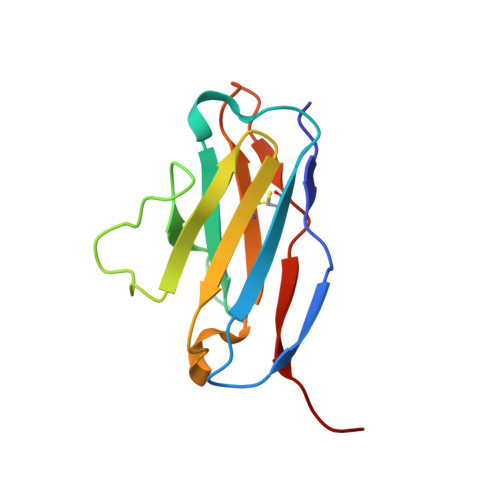Autoreactivity and Exceptional CDR Plasticity (but Not Unusual Polyspecificity) Hinder Elicitation of the Anti-HIV Antibody 4E10.
Finton, K.A., Larimore, K., Larman, H.B., Friend, D., Correnti, C., Rupert, P.B., Elledge, S.J., Greenberg, P.D., Strong, R.K.(2013) PLoS Pathog 9: e1003639-e1003639
- PubMed: 24086134
- DOI: https://doi.org/10.1371/journal.ppat.1003639
- Primary Citation of Related Structures:
4LLV - PubMed Abstract:
The broadly-neutralizing anti-HIV antibody 4E10 recognizes an epitope in the membrane-proximal external region of the HIV envelope protein gp41. Previous attempts to elicit 4E10 by vaccination with envelope-derived or reverse-engineered immunogens have failed. It was presumed that the ontogeny of 4E10-equivalent responses was blocked by inherent autoreactivity and exceptional polyreactivity. We generated 4E10 heavy-chain knock-in mice, which displayed significant B cell dysregulation, consistent with recognition of autoantigen/s by 4E10 and the presumption that tolerance mechanisms may hinder the elicitation of 4E10 or 4E10-equivalent responses. Previously proposed candidate 4E10 autoantigens include the mitochondrial lipid cardiolipin and a nuclear splicing factor, 3B3. However, using carefully-controlled assays, 4E10 bound only weakly to cardiolipin-containing liposomes, but also bound negatively-charged, non-cardiolipin-containing liposomes comparably poorly. 4E10/liposome binding was predominantly mediated by electrostatic interactions rather than presumed hydrophobic interactions. The crystal structure of 4E10 free of bound ligands showed a dramatic restructuring of the combining site, occluding the HIV epitope binding site and revealing profound flexibility, but creating an electropositive pocket consistent with non-specific binding of phospholipid headgroups. These results strongly suggested that antigens other than cardiolipin mediate 4E10 autoreactivity. Using a synthetic peptide library spanning the human proteome, we determined that 4E10 displays limited and focused, but unexceptional, polyspecificity. We also identified a novel autoepitope shared by three ER-resident inositol trisphosphate receptors, validated through binding studies and immunohistochemistry. Tissue staining with 4E10 demonstrated reactivity consistent with the type 1 inositol trisphosphate receptor as the most likely candidate autoantigen, but is inconsistent with splicing factor 3B3. These results demonstrate that 4E10 recognition of liposomes competes with MPER recognition and that HIV antigen and autoepitope recognition may be distinct enough to permit eliciting 4E10-like antibodies, evading autoimmunity through directed engineering. However, 4E10 combining site flexibility, exceptional for a highly-matured antibody, may preclude eliciting 4E10 by conventional immunization strategies.
Organizational Affiliation:
Division of Basic Sciences, Fred Hutchinson Cancer Research Center, Seattle, Washington, United States of America.

















